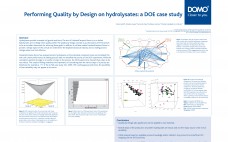During the past decade, single-use bioreactors have become widely accepted for use in cell culture process development and clinical manufacturing. Their key benefits over stainless steel bioreactors are flexibility, cost, and time savings associated with the reduction of cross-contamination risks (1). Here, we describe our approach to development and qualification of the Biostat STR single-use, stirred-tank bioreactor. Unlike other stirred single-use bioreactors, it offers a similar design to that of well-established, conventional (stainless steel) stirred-tank bioreactors. Disposability of the single-use…
Biochemicals/Raw Materials
The Influence of Polymer Processing on Extractables and Leachables
Polymers provide a unique set of material properties, including toughness, chemical resistance, versatility, and low cost for both multiple-use and single-use bioprocessing systems. Polymer materials are manufactured as fittings and tubing for research and development (R&D) laboratories, as containers for bulk chemical and biological storage, as filters and separation technologies for downstream processing, and as containers and bottles for drug substance storage. These components and systems are helping drug companies improve their manufacturing flexibility, reduce their operating costs and capital…
PEGylation of Biologics
In the 1970s, life-science researchers envisioned protein therapeutics as the ultimate targeted therapy. Companies could use them to address genetic deficiencies and cancer, among other disease classes, as well as to nudge the immune system for treating autoimmune disorders. The first therapeutic proteins were derived from animal or microbial cells, so patients launched immune responses to them that could curtail their activity and produce dangerous side effects. PEGylation was initially used to prevent immune responses with such drugs. PEG is…
Antibodies, Bioassays, and Cells
It’s no surprise that immunochemistry forms a broad and solid basis of biopharmaceutical analytical laboratory work. Immunochemicals include antibiotics and antigens, nucleic acids and nucleotides, enzymes, lipids, antioxidants, probes and dyes, and proteins and peptides. Available from companies such as Advanced Immunochemical, Immundiagnostik, Lampire Biological Laboratories, and Rockland Antibodies and Assays, their many uses include antibody isotyping and fragmentation. Adjuvants, buffers, assay kits, target biomolecules, and phage-display systems support those applications. Because background and off-target effects complicate the study of…
Screening Yeastolate Raw Material Used in Insect Cell Culture Media
Insect cell culture is widely used as an industrial platform in recombinant protein production for research and diagnostics (1, 3,4,5). Many commercial yeastolate products are intended as nutritional supplements for not only insect cell culture, but also for mammalian cell culture and bacterial fermentation applications (6,7,8,9,10,11,12,13,14,15). Yeastolate plays an important role in modern biological production because it can be very effective in promoting insect cell growth and enhancing production of recombinant proteins. The product is known to contain amino acids,…
Attaining Next-Level Titers in CHO Fed-Batch Cultures
Taking full advantage of high cell-specific productivity of recombinant proteins requires use of robust fed-batch processes involving addition of one or more concentrated nutrient solutions. Proportionately large amounts of concentrated nutrient supplements are often needed to support the stoichiometrically balanced metabolic requirements of high-density cell cultures. Large feed additions ultimately dilute the final product at harvest, but attempts to minimize feed volumes often lead to multiple concentrated acidic and basic subgroups. Those impart additional complexity to manufacturing processes.…
Performing Quality by Design on hydrolysates: a DOE case study
Hydrolysates provide increased cell growth and titers. The aim of FrieslandCampina Domo is to re-define hydrolysates and re-design their quality profile. The Quality by Design concept as put forward by the FDA proves to be an excellent framework for achieving these goals. In addition it will also enable FrieslandCampina Domo to provide a Design Space of this critical raw material for the biopharmaceutical industry and so making process changes easier and cost effective. FrieslandCampina Domo has analysed protein hydrolysates at…
Meeting Increased Demands on Cell-Based Processes By Using Defined Media Supplements
Rapidly increasing demand for cell-derived products has placed huge pressures on the biomanufacturing industry’s production capacity requirements. Media development strategies continue to be a primary focus for optimizing output from cell culture systems. Animal cells used in manufacturing protein products have complex nutrient requirements specific for each cell type, clone, and product. Individual nutrient requirements were once addressed by using serum-based media rich in growth factors and supplements, which provided an optimal culture environment for cell growth and productivity (1).…
NIR Spectroscopy Analysis of Phosphate Salts
Confirmation of raw material quality is a vital part of biopharmaceutical manufacturing processing. Incorrect or poor-quality vendor materials account for a considerable portion of failed and recalled product. To prevent these expensive problems, strict quality control (QC) procedures are often implemented and used to screen for inappropriate incoming materials. QC procedures commonly used are chemical tests that involve removing samples to a laboratory and performing, which can at times be complex, time-consuming, and laborious protocols. A common test procedure that…
Albumin: A robust pharmaceutical excipient in the stabilization of protein therapeutics
Optimal formulation of peptide and protein pharmaceuticals into efficacious dosage forms to ensure sufficient stability and provide acceptable shelf life is critical. To achieve a stable pharmaceutical drug product, excipients are often added to the protein drug substance. In this study, we investigate recombinant human albumin (rAlbumin) for its ability to prevent or minimize physical and chemical degradation of two allelic variants of the recombinant malaria vaccine candidate, merozoite surface protein 2 (MSP2), in various test formulations. The studies establish…


